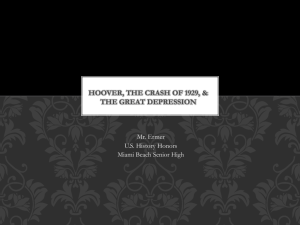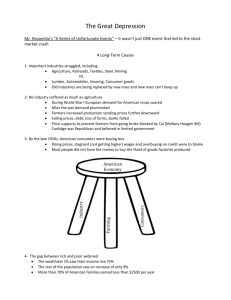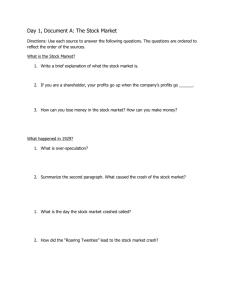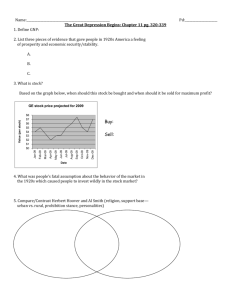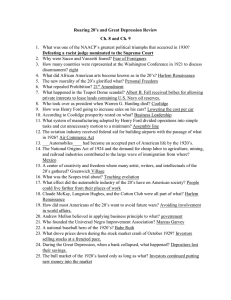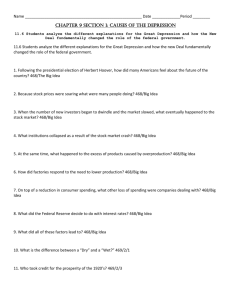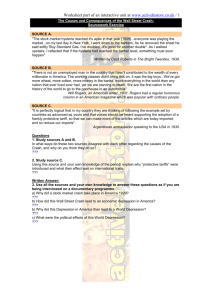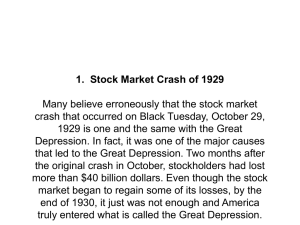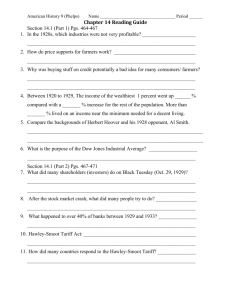here - The University of Texas at Arlington
advertisement
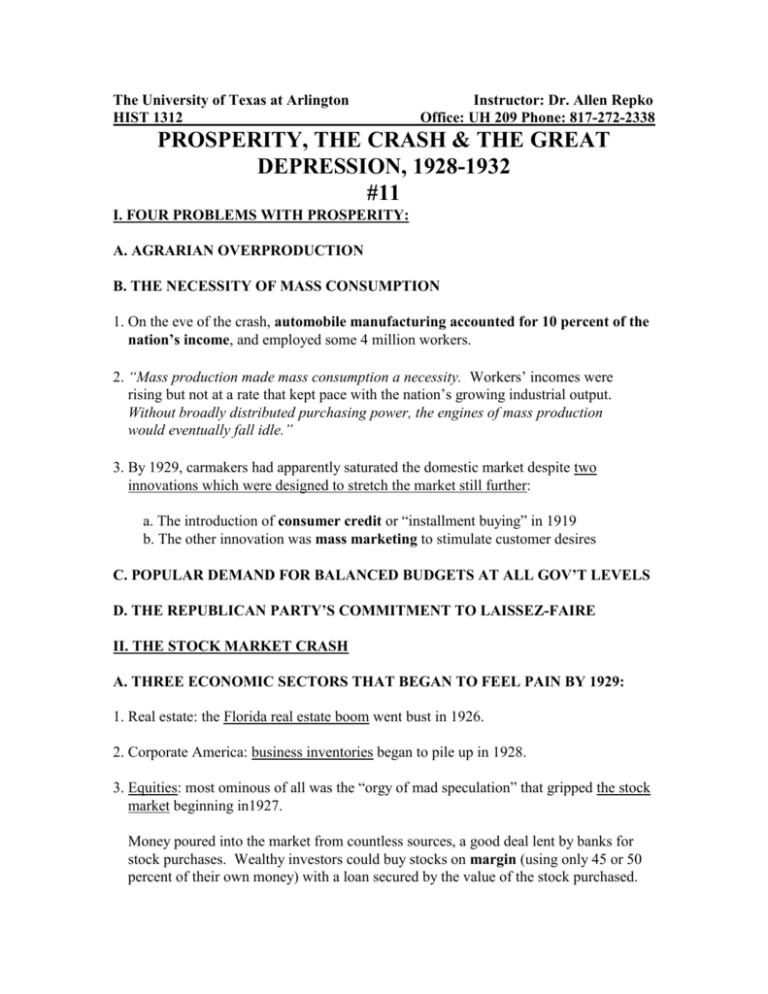
The University of Texas at Arlington HIST 1312 Instructor: Dr. Allen Repko Office: UH 209 Phone: 817-272-2338 PROSPERITY, THE CRASH & THE GREAT DEPRESSION, 1928-1932 #11 I. FOUR PROBLEMS WITH PROSPERITY: A. AGRARIAN OVERPRODUCTION B. THE NECESSITY OF MASS CONSUMPTION 1. On the eve of the crash, automobile manufacturing accounted for 10 percent of the nation’s income, and employed some 4 million workers. 2. “Mass production made mass consumption a necessity. Workers’ incomes were rising but not at a rate that kept pace with the nation’s growing industrial output. Without broadly distributed purchasing power, the engines of mass production would eventually fall idle.” 3. By 1929, carmakers had apparently saturated the domestic market despite two innovations which were designed to stretch the market still further: a. The introduction of consumer credit or “installment buying” in 1919 b. The other innovation was mass marketing to stimulate customer desires C. POPULAR DEMAND FOR BALANCED BUDGETS AT ALL GOV’T LEVELS D. THE REPUBLICAN PARTY’S COMMITMENT TO LAISSEZ-FAIRE II. THE STOCK MARKET CRASH A. THREE ECONOMIC SECTORS THAT BEGAN TO FEEL PAIN BY 1929: 1. Real estate: the Florida real estate boom went bust in 1926. 2. Corporate America: business inventories began to pile up in 1928. 3. Equities: most ominous of all was the “orgy of mad speculation” that gripped the stock market beginning in1927. Money poured into the market from countless sources, a good deal lent by banks for stock purchases. Wealthy investors could buy stocks on margin (using only 45 or 50 percent of their own money) with a loan secured by the value of the stock purchased. B. THE FIRST RUMBLES OF DISTRESS WERE HEARD IN SEPTEMBER 1929 WHEN STOCK PRICES BROKE UNEXPECTEDLY, THOUGH THEY SWIFTLY RECOVERED. 1. But since the average American (97.5%) owned no stock in 1929 the Crash in itself had little direct or immediate economic effect on the typical American. The Depression, however, would be another matter. III. FROM COMPLACENCY TO PANIC & DEPRESSION A. UNTIL THE LAST WEEKS OF 1930, AMERICANS ASSUMED THAT THEY WERE CAUGHT UP IN YET ANOTHER OF THE ROUTINE BUSINESS CYCLE DOWNSWINGS B. TWO REASONS WHY AMERICANS WERE SANGUINE ABOUT THE ECONOMY: 1. They had just elected Herbert Hoover, “The Great Engineer,” President. Hoover believed the chief role of government was to step in where voluntarism had failed, but only after a fair trial. Government was not the first, but the last, resort. 2. Orthodox economic theory held that business downturns were inevitable parts of the business cycle. Accordingly, government should not interfere with the natural course of recovery in the economic organism. C. HOOVER’S ANTI-DEPRESSION PROGRAM FAILED FOR TWO REASONS: 1. The federal government was so small that its actions had little effect. 2. The amount of money the administration was willing to spend was too small. D. FOUR FACTORS THAT CONTRIBUTED TO THE COLLAPSE? 1. The economy was extremely vulnerable to a crash, characterized by “An orgy of financial manipulation, wild speculative ventures, and reckless practices….” 2. There was trouble on the farms. 3. “There was serious maldistribution of income. In 1929, 80 percent of the nation’s families—roughly 21.5 million households—had no savings whatsoever. The 24,000 families at the top—0.1 percent—held 34 percent of all savings.” 4. Fiscal irresponsibility: “It was a prosperity based largely on speculation, easy credit, and foolish spending.”

